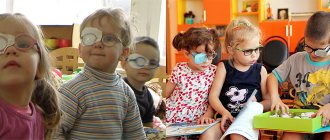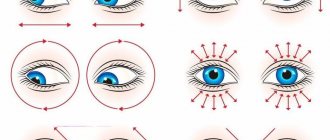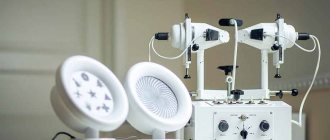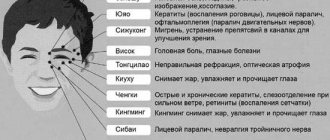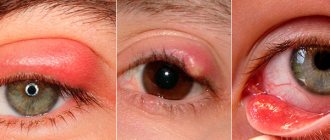Age characteristics
The causes of visual impairment in children in newborns are usually congenital and indicate organic lesions of the visual analyzer or nerve pathways responsible for the formation of connections between the perceptive photosensitive receptors and the visual center in the brain.
Newborns
The baby initially has some visual reflexes - constriction and dilation of the pupils depending on the lighting (light sensitivity), tracking moving objects. The start to the formation of perception of the external world through vision is light stimulation of the retina. Sensitivity to light in a newborn is very low, and only by the end of the first six months of life does it reach slightly more than half the level of an adult. You may notice that the baby's pupils dilate and contract much more slowly depending on the lighting. But the physiological development of children is gradually reflected in the improvement of the functions of light sensitivity, object, color and spatial vision.
Three to six months
By the end of the third month of life, the child develops central vision. When he is able not only to detect an object, but also to recognize it and distinguish it from others. The recognition function indicates the normal formation of the intellectual ability of the brain.
In infants, the eyes cannot remain aligned with the central axis for some time.
Stimulation of the retina with light gradually leads to the development of binocular vision. Stimulation of the fovea causes the eyes to fixate on the light source and, repeating this over and over again, both eyes begin to move in concert. The normal development of binocular vision gives a person the ability to see three-dimensional vision, which allows one to appreciate depth and space. This skill is formed in a child even earlier than other indicators of monocular vision, since three-dimensional vision in humans is the result of evolution and a necessary condition for the survival of our species. A child masters close space in the first couple of months of life.
During this same period of life, the baby begins to recognize colors. The first color that a child easily recognizes is red. Green and similar short-wavelength colors are perceived worse. A baby's field of vision is much narrower than that of an adult. In preschool children, the visual field is 10% smaller than in an adult, but by the age of 7–8 it reaches a normal value. Children also have a slightly larger blind spot, on average 2 cm along each axis. This is explained by the smaller relative size of the eyeball, which also reaches normal size by 10–14 years.
First year
By the tenth month, the baby's vision allows him to recognize geometric shapes. In the second half of the year, the child masters distant space and three-dimensional vision skills improve. The ability to look at near and far makes the accommodative apparatus of the eye work and trains the extraocular muscles.
A great impetus to the development of understanding of space and orientation comes from the beginning of active motor activity. The brain learns to compare the movement of the body in space with changes in the size of visual images.
Junior preschool age
Preschoolers develop an understanding of the drawn image of objects. Three-dimensional perception of objects and visual acuity are formed in children just in time for the start of school. From the time a child begins to speak, visual images reinforce his speech and contribute to the development of abstract thinking.
At five years old, children already have fairly developed color vision, but its improvement continues. Color vision disorders at this age are proportional to adults and do not differ in incidence in both sexes.
High degree of hypermetropia in children
It should be taken into account that in newborns, visual acuity is very low - 0.005-0.015 diopters; almost all of them have farsightedness. These indicators do not indicate visual impairment in children and are physiological, corresponding to age-related development. Visual acuity gradually increases to 0.3 diopters by the end of the first months, 0.6 diopters by the end of the second year and reaches 1.0 diopters. by 7–10 years.
Thus, the correct formation of vision in a child is influenced not only by innate mechanisms, but also by the circumstances that have to be encountered in the process of growth and development.
Read the abstract on pedagogy: “Visual impairment in children” Page 1
(Back)
The “read” function is used to familiarize yourself with the work. The markup, tables and pictures of the document may be displayed incorrectly or not in full!
Discipline "Pedagogy"
Topic of the course work: “Features of a teacher’s work in a school for children with visual impairments”
2004
INTRODUCTION
Vision is one of the most interesting natural phenomena. Hundreds of researchers in many laboratories around the world are working on the study of vision and its subtle mechanisms.
Vision provides people with 90% of the information perceived from the outside world.
Good vision is necessary for a person for any activity: study, recreation, everyday life. And everyone should understand how important it is to protect and preserve vision.
Losing vision, especially in childhood, is a tragedy. Since the child’s body is very susceptible to all kinds of influences, special attention should be paid to vision in childhood.
The lack of movement of a modern person inevitably has a detrimental effect on the functional properties of the visual analyzer - our eyes. On the other hand, excessive information load on the eyes and brain leads to serious disorders and diseases. In developed countries, every fourth person is myopic. Age-related changes in the eye also increase, leading to farsightedness. And this issue has become especially acute recently due to the harmful effects of displays and computers on vision. One of the main reasons for this increase in eye disorders is the lack of attention on the part of parents, doctors and teachers to the issues of visual hygiene and lighting.
The choice of the topic of the course work is not accidental. I work at the city “Center for Vision Protection for Children and Adolescents” and every day I deal with hundreds of children with visual impairments. This problem is very close to me.
The purpose of this course work is to study and analyze in detail the causes of visual impairment in children by systematizing and summarizing scattered information from various sources.
Task: to determine specific actions on the part of teachers to prevent these violations.
Or prove that only through the joint action of doctors, teachers and parents can early vision pathologies be preserved or prevented.I. VISUAL IMPAIRMENT IN CHILDREN—
BIG SOCIAL HYGIENE PROBLEM
Visual disorders are associated not only with the conditions of visual work, but also with other broad social and everyday conditions. These are factors such as nutrition, in particular vitamin deficiency, natural conditions, climate. A connection has been established between visual impairment and health status. The growth and development of the organ of vision itself, hereditary predisposition, etc. are important. The state of the nervous system also plays an important role. High voltage n.s. and irritability may also predispose to the development of visual disorders.
In other words, it is impossible to single out one factor influencing the development of visual impairment. One can only think about the predominant importance of one or another factor in specific conditions.
Based on this situation, it is necessary to consider visual impairment in children as a large, complex problem.
- 1. Anatomical and physiological features
visual analyzerBefore you imagine how the organ of vision develops as the child grows and what needs to be done to avoid the appearance of visual disorders,
Pathological conditions
Types of visual impairment that can be detected in childhood:
- Hyperopia is farsightedness, which can be true or hidden. The eye may have a short optical axis; the image is focused behind the retina. Difficulties arise when it is necessary to look at objects close-up.
- Myopia is myopia, a disorder in which the eye is too large along the anterior-posterior axis for focus to occur on the retina. The image is formed in front of it, so objects located at a distant distance are poorly distinguished.
- Astigmatism is a disorder in which the curvature of the cornea is not identical in all axes, and light rays, refracted differently, do not produce a single clear image on the retina. The baby has difficulty seeing at any distance.
- Strabismus is the position of the eyeball when it deviates from the central axis. It can be congenital or provoked by uneven tension of the oculomotor muscles. The eyes can deviate both horizontally and vertically.
- Amblyopia - if the brain cannot receive useful information from the visual analyzer, then it gradually begins to ignore its signals. Thus, the “lazy eye” syndrome occurs. The child develops vision through one stronger eye.
Based on the degree of visual impairment, several categories of children can be distinguished:
- Visually impaired - visual acuity 0.05–0.2 diopters. These kids have no restrictions on writing or reading.
- Partially blind – visual acuity is maintained at 0.05–0.4 diopters. The child can distinguish light, there are visual images.
- Blind - the visual analyzer has stopped developing, there is no figurative perception. The strongest eye can have residual vision of up to 0.04 diopters. In this case, education is in a compensatory kindergarten or school or at home.
- Completely blind - visual images have never been formed; training is possible at home.
Visually impaired children still have the opportunity to learn
Consultation “Organization of visual work for children with visual impairments”
Yulia Lushanova
Consultation “Organization of visual work for children with visual impairments”
ORGANIZATION OF VISUAL WORK FOR CHILDREN WITH VISUAL IMPAIRMENTS
The protection and development of vision of partially sighted, visually impaired and preschool children with functional visual impairments (strabismus, amblyopia) is one of the most important goals facing typhology teachers, educators and parents of the child. It is achieved by carrying out a wide range of interacting therapeutic, hygienic and psychological-pedagogical measures.
According to the established classification, persons whose visual acuity ranges from 0 to 0.04 are classified as blind. Thus, the blind population includes people who are completely blind (totally blind) and have residual vision (with visual acuity from light perception to 0.04).
Totally blind children certainly use touch and hearing to obtain educational information. Blind children with residual vision will also receive basic educational information through touch and hearing, so in the presence of such a deep lesion, the use of vision for a long time negatively affects its further development. However, in the process of training and education, residual vision is not ignored, since it gives children additional information about the environment. Children with visual acuity from 0.05 to 0.2 are included in the category of visually impaired, and can already actively work with the help of vision, subject to certain hygienic requirements.
The most important aspects of organizing the visual work of a preschooler with visual impairment are:
Workplace
A rationally organized workplace makes it possible to provide the student with the correct working posture. The correct working posture is determined by the following rules:
the chair is moved beyond the edge of the desk by 10 cm, the distance between the body and the table is a fist;
the rule of three right angles: back - thigh, thigh - lower leg, lower leg - foot (if necessary, a footrest can be used);
the head is tilted, the back is straight, the shoulders are at the same level, the lower back rests on the back of the chair;
mandatory use of a book stand with an adjustable tilt angle, tilt angle: 15-20 degrees (neck muscles do not get tired, illumination improves, approximately the same distance to the eyes of individual parts of the text is ensured);
the distance from the eyes to the text is approximately 30-35 cm; if necessary, the child is encouraged to use a magnifying glass;
In rooms where children with visual impairments study, it is necessary to ensure left-side natural lighting of workplaces. Artificial lighting of premises and workplaces can be general and local. Ceiling fluorescent lamps are used as sources of general lighting; incandescent or fluorescent lamps are used for local lighting in the workplace. The light on the workplace should fall from the left from the front, excluding shading and without creating blinding glare. The illumination on the desktop of a visually impaired student should be 500 lux, and during practical and laboratory work - 1500 lux. The illumination of stairs, toilet and dressing rooms, and the dining room is recommended to be at least 300 lux.
It has been established that when illumination decreases by 70-150 lux, the acuity of central vision decreases sharply. With tired vision, visually impaired people begin to experience difficulties in the process of reading and writing (the shape and configuration of letters seem blurry, indistinct, students begin to strain the muscular system of the eye, which leads to disruption of the adaptation function of the visual system (gaze fixation and tracking suffer).
The required degree of illumination largely depends on the nature of the visual impairment:
for high myopia, optic nerve atrophy, retinal pigmentary degeneration, increased illumination is required - 700-1500 lux;
for cataracts – 200-400 lux;
albinism – up to 200 lux;
Children with photophobia should be kept away from light sources.
Seating children according to vision
Children with myopia are seated closer to the visual material (1st row - children with low visual acuity 0.4; 2nd row - children with visual acuity 0.4/0.6; 3rd row - children with visual acuity 0.6/1.0) .
Children with divergent strabismus are seated in the center.
Children with convergent strabismus are seated at the far tables.
If a child has occlusion of the right eye, he sits to the right of the teacher.
If a child has occlusion of the right eye, then he sits to the left of the teacher.
Left-handed children with visual impairments and children with photophobia should not be seated close to the window on a bright sunny day, as the sharpness of the shadow from the writing hand increases.
Visual load
Z. G. Ermolovich notes that continuous visual work for visually impaired children should not exceed 8-10 minutes, for partially sighted children - 5 minutes. When organizing the educational process of children with diseases of the retina and optic nerve, an educator, a teacher-defectologist (typhlopedagogue) must necessarily obtain advice from an ophthalmologist about the individual permissible visual loads for children with severe visual impairments.
Thus, the practice of teaching children with a visual diagnosis of nystagmus indicates their rapid fatigue. With nystagmus, the eyes constantly make spontaneous oscillatory movements of varying amplitudes, which is why the image on the retina is always out of focus. The pace of work of children with nystagmus is slow, and the effort (tension) is significant.
Relieving visual fatigue
The purpose of visual gymnastics is to relieve visual fatigue and prepare the visual analyzer for the upcoming work.
Visual gymnastics consists of special exercises. There are three main groups of visual gymnastics exercises:
Gymnastics to relieve visual fatigue (these are simple manipulations that help relax tense muscles: frequent blinking, squinting, lightly closing the eyelids, closing the eyes, stroking closed eyes with fingertips, light pressure, palm massage and light kneading, etc. During In many modern brochures, following W. Bates, such simple exercises for relieving visual stress and restoring visual performance are defined as a relaxation complex (G. G. Demirchoglyan);
Gymnastics aimed at strengthening the accommodative muscles of the eyes (translating the gaze from an object located nearby to an object located in the distance); Exercise “Mark” (translation of the gaze from an object located nearby to an object located in the distance);
Gymnastics aimed at strengthening the extraocular muscles.
Demonstration of visibility
When teaching blind and visually impaired children, various visual aids are used to a much greater extent than when working with children with normal vision. This is due to the fact that a normally sighted child from early childhood acquires the necessary information about the world around him without any special conditions. Moreover, 90% of this information is visual. A child with profound visual pathology needs targeted training in ways to become familiar with the world around him. This is impossible without the use of special visual aids, since direct sensory perception of many objects or phenomena is often difficult or inaccessible.
The use of visualization stimulates cognitive activity, allows you to maintain interest in classes, and present even the most difficult program material in an entertaining and accessible form.
Various types of visual material are used in teaching children with visual impairments.
Visual aids
1. Natural visual aids: objects from the immediate environment, animals, plants, vegetables, fruits, etc., which are specially selected for the lesson or observed during walks and excursions.
2. Volumetric visual aids: dummies, stuffed animals and birds, models, layouts, geometric bodies.
3. Didactic toys: dolls, doll furniture, dishes, toys depicting animals, birds, insects, etc.
4. Visual visual aids: illustrations for fairy tales, stories, poems, reproductions of paintings, photographic materials, slides, slides, film and video materials, posters
5. Graphic visual aids: tables, diagrams, plans.
6. Symbolic visual aids: historical, geographical, biological maps.
7. Relief visual aids: include illustrative, graphic and symbolic visibility: relief-dot and bas-relief subject and subject images, as well as diagrams, plans, tables made in this way.
Visual material can be demonstration or handout. Demonstration visuals are used to show the whole group of children; the handout is designed to work with one child.
The perception of natural clarity is of particular importance for totally blind and blind children who have residual vision that does not allow them to clearly see surrounding objects. The uniqueness of sensory cognition of children in this category determines the slowness and fragmentation of their perception. Through natural clarity with the help of intact sense organs, such children receive more complete information about various objects and phenomena, that is, information that is adequate for them in terms of visual significance.
When children are first introduced to the program material (“Vegetables and fruits,” “Furniture,” “Utensils,” etc.), natural objects must be presented as visual aids. Only after a thorough study of their properties (softness, hardness or elasticity, smell and taste) in the following classes and lessons can you move on to dummies, models, toys, and visual clarity.
It should be noted that in some situations, when it is impossible to provide children with natural objects for examination (for example, when studying the topic “Transport”), models and toys are first shown, examined and played with. This allows children with low visual acuity to later - when observing real objects transport on excursions - recognize them even at some distance.
Natural objects should be widely used as handouts in various classes and lessons, for example, in special correctional classes when teaching preschool children.
Requirements for natural visibility
Objects should be convenient for visual and tactile examination.
Brightly colored.
Traditional, easily recognizable shape.
The main details should be clearly expressed and highlighted in color.
Requirements for volumetric visibility
The characteristic features of the objects depicted must be accurately conveyed.
It is important to maintain the correct proportions and relationships between parts of an object in a model or layout.
Requirements for educational toys
They act as models and must have clearly identified main details that characterize the depicted object.
Toys depicting a person or animal must represent all parts of the body and their correct proportions.
Requirements for visual clarity
When selecting or making visual aids of this type, it should be taken into account that the ability to distinguish images depends on the acuity of central vision. So, with visual acuity of 0.01-0.03, the minimum size of the object detail must be at least 15 mm, with visual acuity of 0.04-0.08 - at least 5 mm, with visual acuity of 0.09-0.2 - not less than 3 mm.
You should also take into account the fact that children with visual impairments perceive images in color better than black and white, silhouette and contour ones. The perception of color images stimulates the visual response, activates visual functions, and creates a positive emotional mood in children. In diseases such as strabismus and amblyopia, the perception of certain colors (red, yellow, orange) is especially important, as this disinhibits the cone apparatus of the retina, helping to consolidate the results of treatment aimed at increasing visual acuity. At the same time, you should avoid using the visual clarity of dark blue, dark purple, dark green color shades, since they are worst perceived by children with visual pathology.
The average size of paintings and drawings for individual use should be 27x18cm; The size of the letters for typesetting is at least 12 cm in height and at least 2 cm in width. When preparing text aids, it is necessary to remember that children with visual acuity of 0.2 and above can easily distinguish letters 5.6 mm high from a distance of 33 cm.
When working at a distance (for example, frontal viewing of an object picture), the size of the object increases significantly, while children are located at a distance of 0.5-1.0 m from it.
It is inappropriate to depict objects of the same size on one side of a sheet if in reality they differ in size.
No more than 1-2 images are shown in a row;
The surface of the image should be matte, without glare;
Using techniques to ensure better visibility:
Backlight.
Backgrounding (individual backgrounds, for example, sheets of thick colored cardboard or double-sided flannelgraphs measuring approximately 25 x 35 cm).
Contouring to enhance the sharpness of the edges (however, you should pay attention to ensure that the contour line does not “absorb” the image, especially small details of the subject).
Additional tinting of slightly saturated colors to enhance the brightness of the color characteristics of surfaces.
The minimum number and small area of overlap of one image with another.
Reducing the number of minor parts.
Identification of foreground, middle and background in multi-plane subject images.
The younger the child, the more important it is for his perception of simple shapes and primary colors (red, yellow, green and light blue).
Place the pictures before your eyes in a vertical plane (using a stand) at a distance from the eyes recommended by an ophthalmologist.
When choosing books for visually impaired children, you should focus not only on the font size and number of characters, but also on the quality of the paper; it should not intensively reflect the light flux and, as a result, glare, complicating the process of discrimination.
The image can be converted into an application and examined with your hands.
Requirements for graphic aids
They must be made with clear lines, with a minimum amount of details, must be understandable to children, accessible to their visual perception and comprehension.
Requirements for relief visibility
Designed for perception by children with profound visual pathology.
The manuals must reflect the main features characterizing the subject.
The shape of the object must be conveyed especially accurately, since it is the main information feature.
The correct ratio of parts and proportions.
The use of relief visualization must be accompanied by its correlation with real objects.
It should be noted that when examining visual perception, children with visual impairments should be given twice as much time as those with normal vision. Some children need to be given the opportunity to get closer to the visual evidence being demonstrated and to explore using the sense of touch. In some cases, visuals should be brought into the group before the start of the lesson so that the children can examine it first. After the end of the lesson, this visibility can remain in the group for some time.
Proper organization of visual work for children with visual impairments contributes to significant progress in the development of visual-figurative thinking and visual perception. Children not only develop a visual understanding of objects and phenomena, but also increase visual acuity in the amblyopic eye, and this is the result of effectively organized work by the teacher with children with visual impairments.
Literature:
1. Gaidukevich S. E., Grigorieva T. A., Bal N. N., Zygmanova I. V., Minenkova I. N. Organization of the educational environment for children with special needs of psychophysical development in the conditions of integrated education: textbook. -method. manual / S. E. Gaidukevich, T. A. Grigorieva, N. N. Bal, I. V. Zygmanova, I. N. Minenkova; under general ed. S. E. Gaidukevich, V. V. Checheta. - Mn. : BSPU, 2006. – 98 p.
2. Demirchoglyan G. G., Yankulin V. I. Gymnastics for the eyes. – M.: Physical culture and sport, 1988.
3. How to protect your eyes: Practical advice to help school teachers and preschool teachers. / Compiled by: Kotlyarova I. I., Yakhnitskaya L. K. - Mn. : Technoprint, 1999. 6. William G. Bates. Improving vision without glasses
4. E. N. Podkolzina, Peculiarities of using visual aids in teaching children with visual impairments, Defectology No. 6, 2005, p.
How does this affect the child?
The developmental characteristics of children with visual impairments are formed based on what processes in the development of the visual analyzer went wrong.
General characteristics: 1. Visual impairment hinders the child's development in various areas because the brain does not have the usual stimulation to develop neural connections. These children have slow motor skills, cognitive (cognitive), and language skills.
Against this background, social adaptation is significantly hampered, since the baby cannot fully imitate adults and participate in the behavioral and emotional functioning of society. Visual impairment in adolescents usually causes the next wave of difficulties in socialization. A visually impaired person has to wear glasses, which does not always make him look good, or simply depend on the help of sighted people.
2. The characteristics of children with visual impairment who lost it before the age of 5 should be taken into account. In such cases, they speak of congenital visual impairment, since the baby does not retain visual images in memory that can help in his learning. Children have difficulty understanding complex abstract concepts such as color, spatial distance, spatial relationship, etc.
The visual impairment itself will not affect the child's cognitive processing of other sensory information, but the child will have deficits in contact with the external environment.
3. Each of the visual impairments differs in its nature, combination and degree. Consequently, the child's development, learning schedule and needs will also differ. Successful socialization requires understanding how a child's visual functioning has impacted his or her development and thus identifying his or her unique educational needs and learning styles, regardless of age. Visual impairment in schoolchildren makes this process somewhat more difficult, but even with residual vision, children can study normally in specialized kindergartens and schools.
Kindergartens and schools for visually impaired children have special programs and methods for developing
4. Diagnosis of children with visual impairments should be made as early as possible, since the functional development of a child’s eyes is completed by the age of 8.
There is an opinion that when one sense organ is lost, others take over part of its functions. This would be true for an adult or a person who initially had good vision but gradually lost this function. For children with congenital visual impairment, the most important stimulator that triggers brain development is lost.
Methodology for diagnostics, development and correction of visual perception in preschool children
Manifestations of visual impairment
Children with visual impairments are divided into subcategories, and defectologists work not with diagnoses, but with similar conditions.
Thus, there is a very diverse subgroup of “Blind Children”. It also includes children who have residual vision, which allows them to identify all the main features of an object (color, size, shape, spatial characteristics). Training within the subgroup “Blind Children” is carried out using the tactile Braille system. Representatives of another subgroup - “Visually impaired children” - learn on the basis of printed aids, but need to organize special conditions for visual perception. They require well-chosen educational materials, more time to look at objects, and generally attention from adults to their vision problems. Teachers and parents often do not understand the importance of organizing the necessary conditions and make serious mistakes - for example, they force them to take off glasses during a physical education lesson, taking care of the safety of the glasses, but not the child’s visual perception.
Features of visual perception of children with visual impairments:
- Difficulties in recognizing drawings and objects (slowness of review, inaccuracy, omission of image details).
- Slowness, fragmentation, blurriness, distortion of visual perception.
- Difficulties in visual perception of elements and geometric parameters of shape.
- Difficulties in visually assessing proportions, length, distances.
- Impaired differential color contrast sensitivity.
Diagnostic methods
Examples of tests to identify features of visual perception:
"Vegetables and fruits"
for children 5-7 years old
- Target:
checking the associative differences between colors of different quality-tones.
- Materials:
table with 5 images of fruits and vegetables, multi-colored cards.
- Instructions for the child:
choose the appropriate card.
"Find identical figures"
for children 6-7 years old
- Target:
determining the ability to visually distinguish shapes.
- Material:
blank with various geometric shapes.
- Instructions for the child:
Place dots of different colors on identical figures. Name them.
How to study without damaging your eyesight
Here is a unique guide that helps solve vision problems that are most common in children. Some of them are harmless and easily treatable, while others can lead to irreversible vision loss. It is very important to detect them as early as possible, because timely treatment can stop the pathological process. This book is devoted to a detailed description of congenital and acquired eye diseases in children, as well as various methods of their treatment and prevention. Who is this book for? The book is necessary for all parents who care about the health of their children, because according to statistics, about 50% of schoolchildren graduate from school myopic! Features of the book The book contains a unique author's technique, thanks to which you can avoid wearing glasses without surgical intervention. A must-have for parents who care about their children’s vision, especially with heavy workload at school, which usually results in myopia. The author of this book, ophthalmologist Marina Ilyinskaya, introduces readers to a unique technique for restoring vision in children. Your child will not need glasses if you select a gentle regime for visual stress, teach him special methods of unloading the eyes, and master a unique training set of exercises for the eye muscles. This technique will help the child not only significantly improve visual acuity, but also color perception. Attention! The information contained in the book cannot serve as a substitute for medical advice. You should consult with a specialist before taking any recommended actions.
Buy
Requirements for visual materials in preparatory classes
- Demonstration of objects against a contrasting background.
The best, 100% contrast is a combination of white and black. Reverse contrast is recommended, when a dark object is located on a light background, which is physiologically more easily perceived. However, there are visual pathologies in which, on the contrary, direct contrast is preferable: light on dark.
- Using colors such as red, yellow, orange, green.
This is a prerequisite for working with children with visual pathologies and an important recommendation in general. The listed colors relieve stress on the visual organs. Blue and violet, on the contrary, are difficult to perceive in pathologies.
- Limiting the field of perception by a frame.
This makes it easier for the child to focus on the material that needs to be considered. If the manual does not allow you to draw a frame, you can use colored substrates - for example, cardboard with corners into which the image is inserted. The substrates must be made in the colors recommended for the manuals.
- Use images with outlines and rich colors.
For children with visual impairments, it is better to draw a very thick outline.
- No glossy surfaces.
You only need to use matte film for lamination; it can also be used to remove glare from ready-made glossy materials. Another way to eliminate the glossy cast is to place the manual in a matte file.
- Realistic nature of the images.
Not all children can correctly perceive objects, so when forming ideas about animals and birds, you need to carefully select illustrations. For example, if you take an image of a dog, all four paws must be drawn on it.
The educational and methodological set “Paths”, presented by the Russian Textbook corporation, meets all the listed requirements and can be used for different visual perceptions.
Unique exercises for restoring vision in children according to Professor Ole’s method
This book contains exercises, games and training adapted for children of different ages - from infants to high school students. They will help with the most common vision defects in children - progressive myopia, astigmatism, amblyopia, strabismus, and retinal problems. These simple and easy-to-learn exercises will instill in your child the skills to properly use the organ of vision, and with daily training, the child will see better in just a month!
Buy
Formation of ideas about a planar image of a natural object
A preschooler should be introduced to the manuals in stages:
- A real three-dimensional object or its model, layout, dummy.
- Color image.
- Outline image with solid outline.
- Outline image with broken outline.
- An image noisy with vertical or horizontal parallel lines or a curved line.
- Complex noise: overlaying objects on top of each other.
- Object detail.
If a child can identify an object by detail, then the formation was successful.
Every year the number of children with visual impairments increases. Children with pathologies come to general educational institutions and become - or, in any case, should become - full-fledged participants in the educational process. If a child lags behind due to visual impairments and becomes unsuccessful in his studies, this leads to school negativism and reluctance to learn. With due attention, examination, forecasting, and with the correct organization of the conditions of visual perception, some problems (such as impaired vision, impaired color perception) can be corrected and eliminated.
Science is about the eyes: how to restore vigilance. Doctor's recommendations with exercises
Computers and mobile devices, the urban rhythm of life and stress put an unbearable strain on the eyes.
“It’s not difficult to take care of your vision,” says Igor Borisovich Medvedev, Svyatoslav Fedorov’s closest student, academician of the Russian Academy of Medical Sciences, professor, doctor of medical sciences, ophthalmic surgeon, member of many foreign ophthalmological academies and societies. The reference book contains the most up-to-date and useful information about 24 eye diseases and provides special nutritional recommendations for eye health. In addition, create an individual health complex, choosing from 78 exercises that help with myopia, farsightedness, and eye fatigue. Thanks to the recommendations of the leading ophthalmologist in Russia, you will be able to preserve your vision for a long time, and if necessary, you will know exactly when to see an ophthalmologist and what questions to ask him. Take care of your eyesight! Buy
Survey
Traditional methods of examination in ophthalmology are ophthalmoscopy and testing of visual acuity using the Orlova or Sivtsev table. For children with visual impairments, there are special techniques that also make it possible to establish the quality of connections between the visual analyzer and the brain and its other functions. For this purpose, diagnostics are carried out using the Solntsev L.N. method, which includes assessment of motor skills, associations of speech images with visual representation, the ability to reproduce shapes and images using a drawing, and the ability to imitate the actions of an adult. As a result of the examination, it is possible to identify the level of development of the visual analyzer, mental indicators and learning ability.
